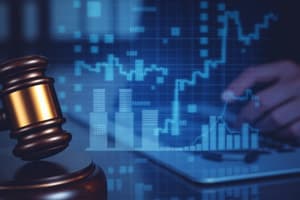Podcast
Questions and Answers
What is the Economic Model of Crime?
What is the Economic Model of Crime?
- A model that states a criminal act is performed if the expected benefits from committing a crime exceed the expected costs (correct)
- A model that ignores the costs involved in crime
- A model that emphasizes only the social implications of crime
- A model that suggests crime is always wrong
A criminal offense is committed when benefits exceed the ____.
A criminal offense is committed when benefits exceed the ____.
cost
What does EB > EC indicate?
What does EB > EC indicate?
Commit the crime
What does EB < EC indicate?
What does EB < EC indicate?
What are the costs of committing a crime?
What are the costs of committing a crime?
What is the opportunity cost of committing a crime?
What is the opportunity cost of committing a crime?
What are punishment costs of committing a crime?
What are punishment costs of committing a crime?
What does stigma of criminal activity refer to?
What does stigma of criminal activity refer to?
What is recidivism?
What is recidivism?
How do you estimate an individual's expected penalty?
How do you estimate an individual's expected penalty?
What are expected benefits in the context of crime?
What are expected benefits in the context of crime?
What is a discount rate?
What is a discount rate?
Do criminals have a higher or lower discount rate?
Do criminals have a higher or lower discount rate?
A high discount rate leads to less crime.
A high discount rate leads to less crime.
What is the effect of police on crime?
What is the effect of police on crime?
What negative effects does imprisonment have on crime rates?
What negative effects does imprisonment have on crime rates?
What is the rarity of capital punishment's impact on crime?
What is the rarity of capital punishment's impact on crime?
What is the impact of gun laws on crime?
What is the impact of gun laws on crime?
Income has a direct relationship with crime rates.
Income has a direct relationship with crime rates.
How are high wages related to crime rates?
How are high wages related to crime rates?
What correlates with higher levels of crime?
What correlates with higher levels of crime?
The unemployed have lower opportunity cost of crime since they are not giving up ____.
The unemployed have lower opportunity cost of crime since they are not giving up ____.
What is the goal of public law enforcement?
What is the goal of public law enforcement?
What is the purpose of public law enforcement?
What is the purpose of public law enforcement?
What occurs when marginal enforcement costs equal marginal enforcement benefits?
What occurs when marginal enforcement costs equal marginal enforcement benefits?
Factors that indicate the certainty of punishment include probability of punishment, policing levels, arrest rates, and ____.
Factors that indicate the certainty of punishment include probability of punishment, policing levels, arrest rates, and ____.
Factors that indicate the severity of punishment include length of prison terms and level of ____.
Factors that indicate the severity of punishment include length of prison terms and level of ____.
What helps determine a criminal's expected penalty?
What helps determine a criminal's expected penalty?
All combinations of probability and severity should produce _____ levels of deterrence.
All combinations of probability and severity should produce _____ levels of deterrence.
What combination of law enforcement achieves deterrence at the lowest possible cost?
What combination of law enforcement achieves deterrence at the lowest possible cost?
What is the preferred sanction according to criminal theory?
What is the preferred sanction according to criminal theory?
A fine should be set as high as possible to an individual's?
A fine should be set as high as possible to an individual's?
Sanctions should be as __ as possible and probabilities should be as __ as possible to achieve a given level of deterrence.
Sanctions should be as __ as possible and probabilities should be as __ as possible to achieve a given level of deterrence.
Severity of sanctions should increase with?
Severity of sanctions should increase with?
What is the impact of setting penalties for all offenses at the maximum level?
What is the impact of setting penalties for all offenses at the maximum level?
When may the low certainty/high severity combo no longer be optimal?
When may the low certainty/high severity combo no longer be optimal?
What factors contributed to the decrease in crime during the 1990s?
What factors contributed to the decrease in crime during the 1990s?
What factors did not contribute to decreases in crime in the 1990s?
What factors did not contribute to decreases in crime in the 1990s?
Flashcards are hidden until you start studying
Study Notes
Economic Model of Crime
- Criminal acts occur when expected benefits (EB) outweigh expected costs (EC).
- The inequality EB > EC indicates a decision to commit a crime.
Costs of Committing Crime
- Costs include direct material costs, psychic costs, opportunity costs, and potential punishment costs.
- Opportunity cost decreases with income levels, making illegal activities more appealing for lower-income individuals.
Punishment and Recidivism
- Punishment costs encompass formal penalties (fines, prison) and informal sanctions (stigma).
- Stigma leads to social consequences (difficulty finding a spouse) and economic challenges (joblessness).
- Recidivism refers to the tendency to repeat criminal behaviors.
Expected Benefits and Discount Rate
- Expected benefits comprise both monetary and non-monetary rewards of crime.
- Individuals with a high discount rate prioritize immediate gratification over future repercussions.
Crime Prevention Measures
- An increase in police presence correlates with a decrease in crime rates.
- Imprisonment impacts crime reduction through deterrence and incapacitation of offenders.
Capital Punishment and Gun Laws
- Rarity of capital punishment diminishes its deterrent effect.
- Gun laws show mixed evidence; concealed carry may deter crime but results vary.
Income and Unemployment Correlations
- No significant correlation between income and crime rates, but high wages lead to lower crime due to increased opportunity costs.
- Higher unemployment rates are associated with increased crime levels as the unemployed face lower opportunity costs for engaging in crime.
Law Enforcement Objectives
- Public law enforcement aims primarily for deterrence and maximizing social welfare.
- Optimal deterrence occurs when marginal costs of enforcement equate to marginal benefits.
Certainty and Severity of Punishment
- Certainty of punishment relies on policing actions, arrest, conviction, and imprisonment rates.
- Severity is determined by prison terms and financial penalties.
Deterrence Dynamics
- An individual's expected penalty combines the certainty and severity of punishment.
- Ideal deterrence mixes low probability of being caught with high penalties.
Sanction Preferences
- Fines are preferred over imprisonment for cost-effective deterrence.
- Fines should be maximized relative to an individual’s wealth to ensure effective penalties.
Crime Trends in the 1990s
- Notable factors contributing to decreased crime include legalized abortion, a reduction in the crack epidemic, increased prison populations, and higher police numbers.
- Economic factors, changing demographics, and other policies (e.g., gun control, capital punishment) were not significant contributors to crime reduction during this period.
Studying That Suits You
Use AI to generate personalized quizzes and flashcards to suit your learning preferences.




